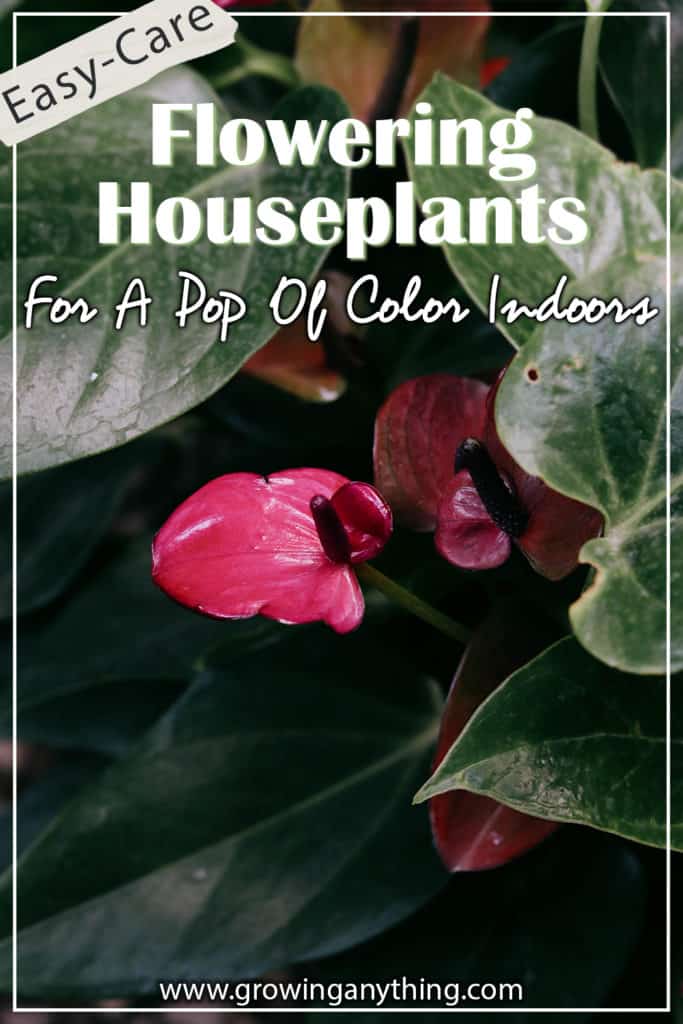25 Easy-Care Flowering Houseplants
Flowering houseplants become a colorful decoration in every home as soon as the first bloom appears. Some of them even bloom several times per year, providing a unique display in every home.
Some wonderful plants bloom outdoors, but the flowers don’t appear indoors, because of the lack of sunlight and different humidity conditions. With my list, you don’t have to worry about it.
Here is the selection of the best plants that survive different conditions indoors, medium and indirect sunlight, and will still provide showy flowers.
Are you ready? Here are the 25 gorgeous plants which bloom indoors!
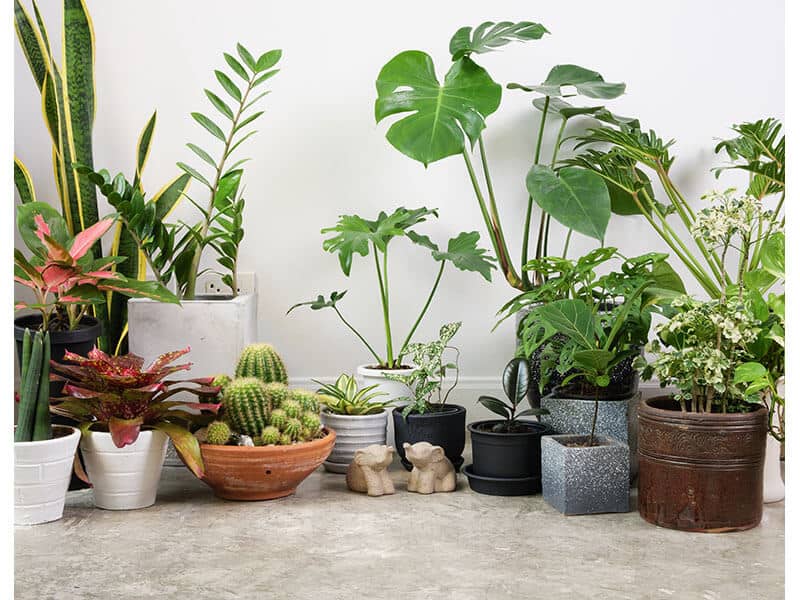
1 Flowering Maple
Abutilon x hybridum or flowering Maple is loved because of its large and bright lantern-shaped flowers. The plant isn’t difficult to grow indoors, but you need to fulfill a few requirements.
Plant your flowering Maple in the pot with excellent drainage and keep the soil moist. The ideal location for the plant is full sun, but it can survive light shade conditions.
The rest is simple, but try not to overwater the plant, as it is the most common way to kill your flowering maple. Water the plant sparsely in the winter when the plant is in a dormant phase.
You can also grow it outdoors.
2 Porcelainflower
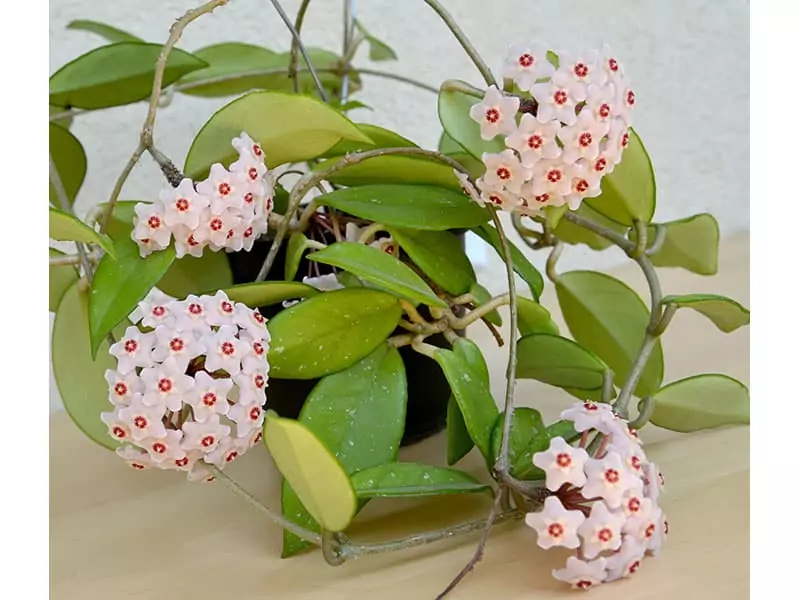
Hoya carnosa is the botanical name of the Porcelainflower plant, sometimes called the Wax plant as well. The plant develops long vines with a waxy and leathery texture. Next, the foliage features speckles in cream white and can benefit from frequent misting.
Hoya carnosa needs support to grow to its full potential. Other growing conditions include medium watering, high humidity and bright indirect light.
Porcelainflower develops lovely star-shaped blooms, with a sweet aroma. There are several cultivars and they all grow well indoors!
3 African Violet
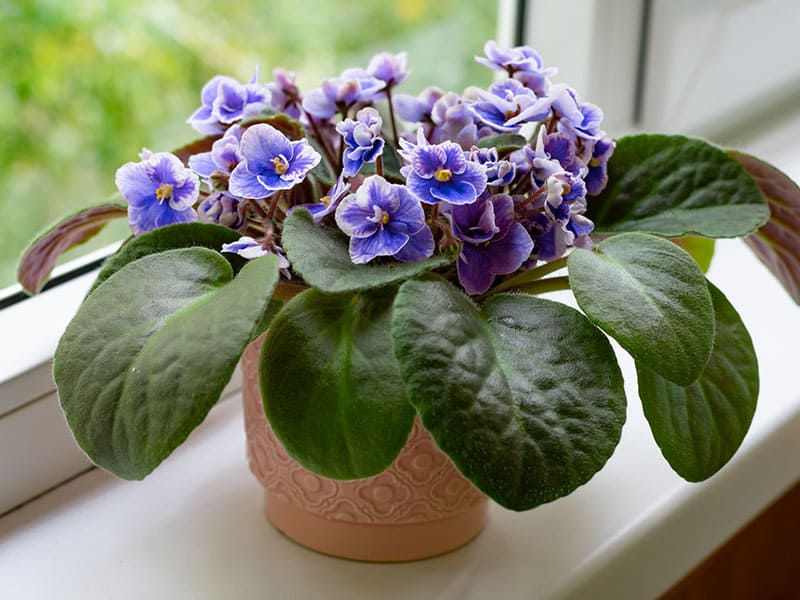
Saintpaulia ionantha is probably the most common houseplant ever. You probably know the plant by its common name – African Violet!
It blooms several times per year and doesn’t require a lot of effort to thrive. African violets feature fuzzy foliage and develop purple, white or pink blooms. The plant doesn’t mind dry indoor air and can live for decades. Therefore, it is a perfect plant for beginners and offices!
But, keep in mind to repot the plant once it overgrows the current pot.
Learn how to prune African Violets properly
4 Wax Begonia
Begonia x semperflorens-cultorum or Wax Begonia plant is a perennial when grown indoors. It is a slow-growing plant at first, but after several months, the plant starts to thrive. You can find varieties with lovely pink, red, white, and bi-colored flowers that will instantly brighten up any space.
If you are into Wax Begonia, keep it in a warm and humid place. Also, the plant needs consistent watering and isn’t drought-tolerant. But choose a well-draining pot and loose soil to prevent the rot from rotting.
Learn more about the Wax Begonia toxicity and most common varieties.
5 Bromeliads
Bromeliads or Bromeliaceae are indoor plants. It is a tropical plant with distinct bloom and upright growing habit. The colorful blooms appear in the middle of the plant, surrounded by narrow leaves. You can find Bromeliads in pink, red, yellow, orange and purple blooms.
Overall, Bromeliads are low-maintenance plants. They need bright light, shallow pots, and occasional use of fertilizer in the growing season.
6 Oxalis
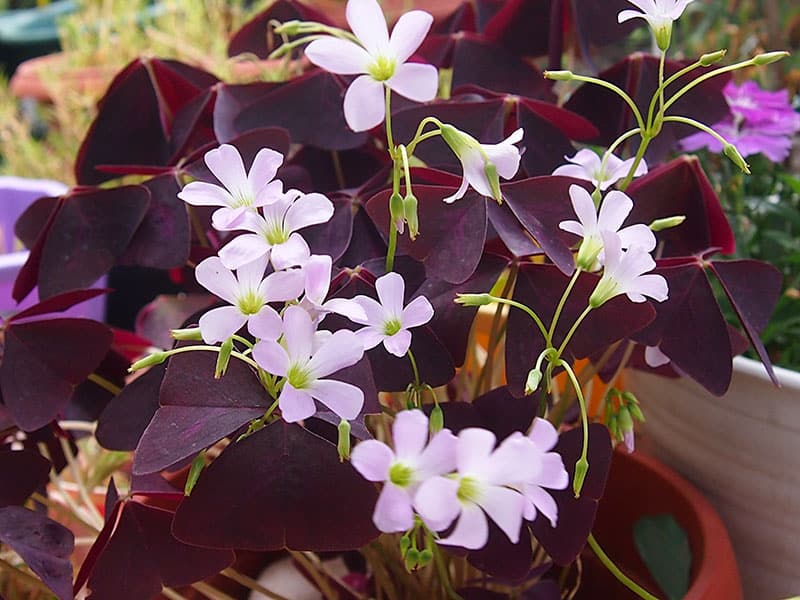
Oxalis triangularis features ornamental foliage and lovely blooms. The plant features purple triangular foliage and is sometimes called purple Shamrocks. Interestingly, the plant is photophilic, so it opens and closes flowers when exposed to light. But, Oxalis does the same with its unusual leaves that look like butterflies!
Oxalis is easy to grow, and perfect for beginners. The plant needs a small amount of moisture and medium light exposure.
7 Anthurium
With its bright and unusual blooms, Anthurium is a favorite statement plant for people who like the contrast between dark red and bright green.
Anthurium needs warm temperatures, on average between 65 and 80 degrees Fahrenheit. The plant is sensitive to sudden changes in temperature, so place it away from the AC unit and fan.
To boost the health of your Anthurium, use a liquid fertilizer during the growing season. Keep in mind that Anthurium has severe toxic properties.
8 Orchid

Don’t shy away from growing Orchids indoors. Some varieties might be trickier to grow. With a couple of tips and tricks, you can successfully grow this beautiful plant.
The plant needs a lot of sunlight, but some varieties are sensitive to strong afternoon sun. The key to growing Orchids is ensuring they are exposed to periods of drying and watering. It ensures consistent growth and enhances blooming. Keep the indoor temperatures between 50 and 85 degrees Fahrenheit.
Here are more ways to keep Orchids alive indoors!
9 Geranium

Pelargonium or Geraniums are popular indoor plants because they bloom year-round. But, you need to ensure the plant gets enough light so it can produce lush and vivid blooms.
Nowadays, you can find various cultivars of Geraniums, including the vine hybrid varieties that look stunning in hanging baskets.
When caring for Geraniums, allow the top inch level of the soil to dry between watering and keep the room temperature consistent.
10 Poinsettia
Euphorbia pulcherrima, Poinsettia, or Christmas rose is an attractive houseplant, often associated with the holiday season. The plant develops bright red bracts, which are often mistaken as flowers. But, it does bloom! In the center of each bract, you can see a bright yellow flower, which gives the plant a festive look!
Poinsettia needs weekly watering, and it is all the plant needs to stay alive. Once the leaves fall, put Poinsettia in a dark and dry place to keep it for the next year. Add fertilizer during the growing season and regularly cut back to enhance new growth!
The trick to get red bracts the next year is to provide dark periods for the plants in the mid-fall. You put a box on top of the plant for at least 12 hours since October. By the holiday season, your Poinsettia will be bright and healthy again!
11 Peace Lily
Spathiphyllum or Peace Lily has excellent air-filtering properties and helps reduce harmful toxins from the air. Because of it, and elegant appearance, low-maintenance nature, and lovely symbolism, Peace Lily is a common houseplant and a perfect choice for beginners.
The plant needs medium light exposure. But if it receives more light, it will produce more and prettier flowers. Also, Peace Lily rarely needs fertilization. You can feed the plant twice a year.
The plant is drought-tolerant and sensitive to overwatering.
12 Gloxinia
Sinningia speciosa is the botanical name of Gloxinia, a plant known for its colorful bell-shaped flowers. The plant blooms in violet, purple, red, burgundy, pink, and white, and some hybrids develop white lines on the edges of large and ruffled petals.
To ensure your Gloxinia repeatedly blooms, repot the plant in the spring using fresh soil. Keep the soil moist and place your Gloxinia where it can receive a lot of bright, indirect light.
Gloxinia needs regular fertilization and a lot of moisture to stay alive.
The plant rarely develops problems, but the most common is root rotting because of poor soil drainage.
13 Jasmine
Many people grow Jasmine indoors because of its elegant appearance and sweet fragrance. The flowers are bright white and star-shaped which stand out against true green foliage.
Another great thing about the Jasmine plant is that you can find hybrids that bloom in winter, so they add a dash of spring during cold winter months!
Jasmine needs a sunny location and acidic to neutral soil pix. To boost the health of your plant, add organic content to the soil. Also, Jasmine needs pruning and fertilization. For most varieties, the ideal time to do it is winter.
Jasmine looks pretty in simple tabletop pots and hanging baskets for wonderful visual effects.
14 Hortensia
Hydrangea or Hortensia is commonly considered an outdoor plant. But, did you know that it makes a stunning houseplant as well? Indoor Hortensia can last for years and it doesn’t require too much effort to stay alive and develop showy flowers. Indoor blooms are slightly smaller than outdoor ones, but they are equally beautiful and colorful!
The plant needs a lot of light to produce blooms but may suffer when exposed to warm afternoon suns. Once the flowers appear, you’ll have to water the plant each day. Ideally, choose distilled or rainwater, because alkaline content in tap water may cause blooms to look washed out.
15 Kalanchoe
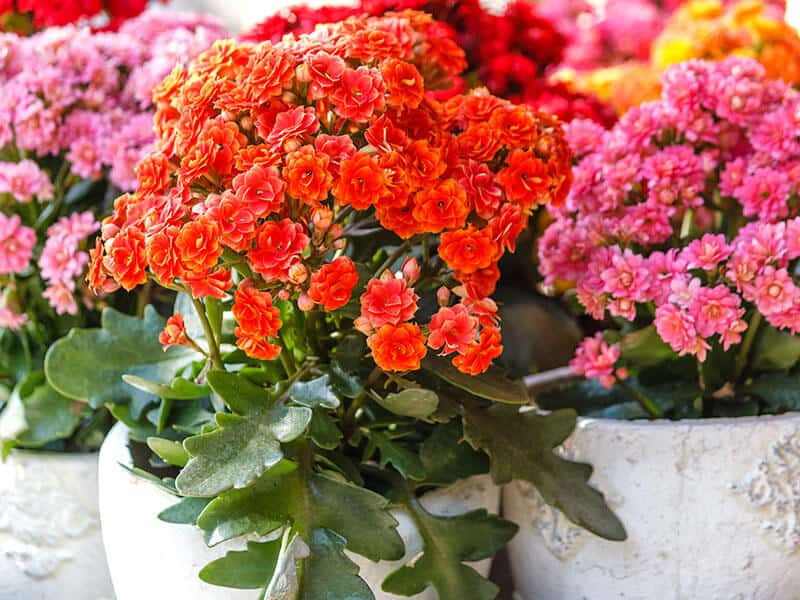
Kalanchoe blossfeldiana is a succulent plant that develops fleshy green foliage and bright flowers. It needs bright and filtered light before it develops flowers. The more light the plant gets, the more flower buds it will produce. Once the first blooming season passes, keep Kalanchoe in the dark for 14 hours a day to enhance new blooms.
Kalanchoe develops tiny, beautiful flowers in pink, orange, red and yellow colors. They remain compact so they are perfect for people who have limited space.
16 Christmas Cactus
Schlumbergera is a scientific name of the unusual houseplant known as the Christmas cactus. The plant flowers in winter, near the holiday season, hence the name. Christmas cactus is a bit tricky to grow, but the propagation is simple. Therefore, you can use it as a Christmas gift!
The plant may survive in low-light conditions, but it will produce prettier flowers if you expose it to sunlight. In spring and summer, the plant needs frequent watering, and the moisture needs slowly reduce in the fall and winter. Ideally, keep the plant in a room where the temperatures are between 60 and 70 degrees Fahrenheit and the humidity is high!
17 Amaryllis
Amaryllis is one of the easiest bulbs to grow indoors. It is the perfect choice to brighten up any winter window setting because of its large flowers!
The plant needs rich potting soil and consistent water. Ideally, the plant will be exposed to bright, indirect light for several hours per day.
Amaryllis has an upright growing habit and develops thick stems. Therefore, provide a supporting stake for the plant. For Amaryllis, you can easily anticipate the blooming season. It is between six and eight weeks after planting in the fall.
18 Lipstick Plant
Aeschynanthus or a Lipstick plant is a blooming indoor plant that develops bright red bursts of flowers between May and September.
The evergreen foliage is glossy and thick and makes a beautiful contrast with bright red, lipstick-red flowers.
On average, the plant grows up to 15 inches. It needs a lot of sunlight and slightly acidic soil to thrive. Don’t forget to repot your plant every April, so the soil is fresh, and the plant is healthy!
Find out how to propagate your Lipstick plant!
19 Chenille
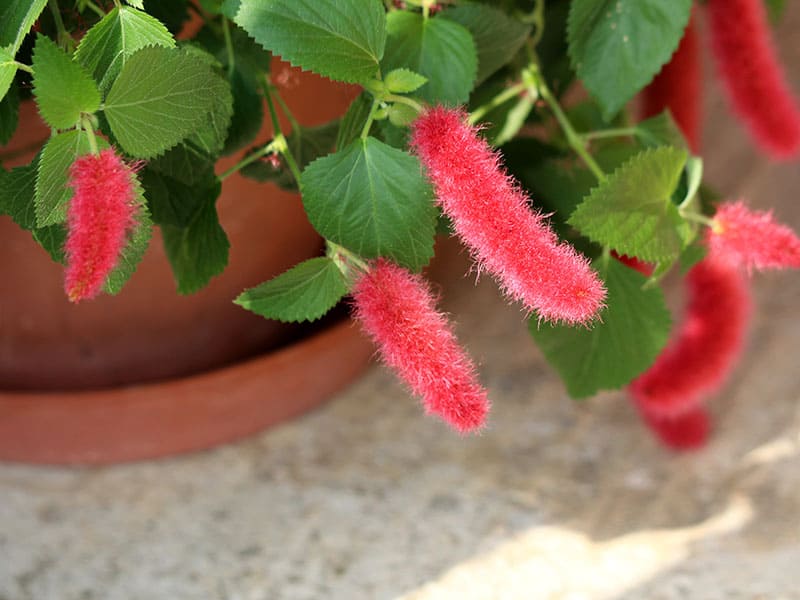
Acalypha hispida or shortly Chenille is a bright light-loving plant. However, the plant can adjust to different lighting conditions, which makes it a handy little plant! An east-facing window will be a perfect location for Chenille.
It is a tropical plant with evergreen foliage and lush and bright blooms. The plant isn’t picky about the soil, but you need to be careful with water. It needs regular watering year-round. The temperatures need to stay warm, and ideally, humidity should be high. You can keep the plant in the bathroom or kitchen until it establishes.
20 Hibiscus
Hibiscus is a tropical plant that loves warm temperatures. Therefore, it is excellent for growing indoors year-round or only throughout winter.
If you care well for your Hibiscus plant, it can survive several decades. Hibiscus needs light and warmth. Water the plant frequently, but remember to empty the saucer to prevent the plant from sitting in the water. Regular fertilization is important during the growing season, so your Hibiscus will develop large and bright flowers.
21 Clivia
Clivia miniata belongs to the same family as Amarilys and has a similar appearance. The plant has a similar visual effect to Orchid but is much easier to grow. Also, it isn’t a typical houseplant, so it will definitely become a conversation starter once the lovely orange blooms appear in winter.
The plant needs cool night temperatures during the fall. During that time, Clivia needs only a small amount of water.
Once the rest period ends, Clivia starts to bloom.
Also, because of the attractive foliage, Clivia is a striking plant year-round.
The best and safe way to repot Clivia
22 Cape Primrose
Streptocarpus is the botanical name of a beautiful houseplant known as Cape Primrose. The plant develops long and narrow velvety leaves and small colorful flowers on top.
Some hybrid varieties feature bi-colored blooms which enhance the plant’s visual effect.
Cape Primrose needs partial sun exposure. But, keep the plant away from bright light. The plant is drought-tolerant. When watering the plant, avoid wetting the leaves, as water can stain the leaves.
In ideal conditions with lots of light, Cape Primrose blooms almost year-round.
Watch the video: Tips for extending the blooming season of Primrose
23 Crown of Thorns
Euphorbia milii or Crown of Thorns comes from Madagascar and is admired for its lovely blooms and high adaptability to different conditions.
If you are interested in the Crown of Thorns plant, keep in mind that it is toxic to humans and animals, so make sure to find the appropriate place for it.
Because it is a tropical plant, Crown of Thorns needs warm temperatures, high humidity, and a lot of light. Avoid overwatering, and water only when the soil is dry to touch. Fertilization every couple of weeks during spring, summer, and fall, helps the plant remain healthy.
24 Cyclamen
Cyclamens are perfect indoor plants! Keep them in a cool room where they receive some light, and their blooming season may extend for several months. Cyclamens don’t do well near radiators or on the sunny windowsill. That is why they are great for hallways and dull corners.
Interestingly, Cyclamen plants go dormant in summer and show all their beauty in winter! Remember to deadhead the spent flowers to prevent the damage from spreading on healthy parts of the plant.
25 Guppy Plant
Nematanthus gregarius, a Guppy plant, goldfish, or a clog plant, has long stems and glossy foliage. It comes from Brazil and develops beautiful, warm-orange flowers. In its native habitat, the Guppy plant grows on trees. Therefore, you can provide a stake or a trellis for it to support upright growth and vining.
The plant needs light, but filtered light and weekly fertilization during the growing season. Blooming season is summer, and once it ends, you’ll have to prune the plant to encourage new growth. That way, your Guppy plant will become bushier and get a richer appearance.
Best styling rules for displaying your indoor plants for a striking visual effect
Everyone Needs Flowers In Their Life
Flowering indoor plants instantly improve the interior space. But, some scientific research shows that it also boosts mood and reduces stress. On top of everything, indoor flowering plants boost creativity, and some provide a healthy indoor environment because of the air-purifying capabilities.
Therefore, the plants from my list make your home look great and improve the way you feel!
Which plant will you choose? I love Clivia plants and Orchids!
If you enjoyed the article, please come back for more peculiar plant lists and growing tips!
